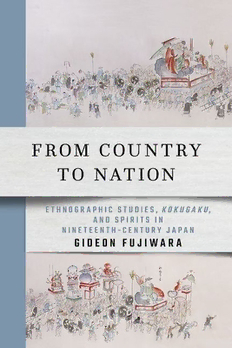
From Country to Nation: Ethnographic Studies, Kokugaku, and Spirits in Nineteenth-Century Japan PDF
Preview From Country to Nation: Ethnographic Studies, Kokugaku, and Spirits in Nineteenth-Century Japan
FROM COUNTRY TO NATION FROM COUNTRY TO NATION Ethnographic Studies, K okugaku , and Spirits in Nineteenth-Century Japan Gideon Fujiwara CORNELL EAST ASIA SERIES AN IMPRINT OF CORNELL UNIVERSITY PRESS Ithaca and London Number 204 in the Cornell East Asia Series Copyright © 2021 by Cornell University A ll rights reserved. Except for brief quotations in a review, this book, or parts thereof, must not be reproduced in any form without permission in writing from the publisher. For information, address Cornell University Press, Sage House, 512 East State Street, Ithaca, New York 14850. Visit our website at cornellpress.cornell.edu. First published 2021 by Cornell University Press Printed in the United States of America Librarians: A Cataloging-in-Publication record is available from the Library of Congress. ISBN 978-1-5017-5393-0 (hard cover) ISBN 978-1-5017-5394-7 (epub) ISBN 978-1-5017-5395-4 (pdf) Tsugaru Customs Painting Scroll (Tsugaru fūzokuga maki) by Satō Senshi. Private collection. Contents List of Tables and Figures vii Acknowledgments ix Explanatory Notes xi Introduction 1 1. Seeing the “Country” of Tsugaru in Northeastern Japan 13 2. Visions of Japan and Other “Countries” in the World 46 3. Hirata K okugaku and the National Network 68 4. The Academy and the Tsugaru Disciples 97 5. Locating Tsugaru within Sacred Japan 123 6. Sacred Mountain, Landscape, and Afterlife 151 7. Supporting the Restoration in War and Ritual 172 8. Modern Society and the Tsugaru Disciples 199 Conclusion: Ethnography, K okugaku , and Community in Modern Japan 229 Appendix 239 Selected List of Characters 241 Bibliography 253 Index 269 Tables and Figures Table 1. List of Hirata Disciples in Tsugaru 240 Figures Cover Image Tsugaru Customs Painting Scroll (T sugaru fūzokuga maki ) by Satō Senshi. Private collection. Digital data courtesy of Aomori Prefectural Museum. 1.1. Map: Early Modern Japan and Hirosaki 15 1.2. Map: Hirosaki domain 16 1.3. Hirosaki castle 17 1.4. Hirao Rosen portrait (Private collection) 29 1.5. Tsuruya Ariyo portrait (G appo sharimoishi ) 36 1.6. “Nebuta image” (T sugaru Customs Painting Scroll ) 41 1.7. “Mount Iwaki worship image” (Private collection) 43 1.8. “Sled pulling image” (T sugaru Customs Painting Scroll ) 44 1.9. “Winter work and tools image” (T sugaru Customs Painting Scroll ) 45 2.1. “Steamship” (T aihei shinwa ) 48 2.2. Map: Rosen’s Visit to Ezo 51 2.3. “Matsumae Harbor image” (H akodate kikō ) 54 2.4. “Official” “Minor official” (Y ōi meiwa ) 58 2.5. “Guangdong officials image” (H akodate kikō ) 60 2.6. “Mochi-pounding in the twelfth month” ( Hakodate kikō ) 64 4.1. Kanehira Kiryō image (G appo sharimoishi ) 105 4.2. Turtles by Kanehira Kiryō 106 5.1. “Thunder beast image, Aki province” (Y ūfu shinron ) 148 6.1. Mount Iwaki 153 vii viii TABLES AND FIGURES 6.2. Torii gate, Iwakiyama Shrine 153 6.3. Iwakiyama Shrine 154 7.1. S hōkonsai ; bird’s-eye-view diagram (Ono Wakasa letter). 194 8.1. Stone monuments honoring Tsuruya Ariyo and Hirao Rosen, Tenmangū Shrine, Nishi Shigemori, Hirosaki 226 9.1. Neputa festival, Hirosaki, August 2011 230 Acknowledgments I am grateful to everyone who supported me in writing this book. Peter Nosco inspired, then supervised, my studies of kokugaku and taught me to think for myself. He guided me at each stage as I wrote this book. Nam-lin Hur taught me Japanese history and the joy of grap- pling with primary sources. Kojima Yasunori introduced me to Hirao Rosen and helped me navigate the “country” of Tsugaru. Anne Walthall shared her insights on Hirata kokugaku and reviewed two versions of this book. Hasegawa Seiichi advised me on early modern history while hosting me at Hirosaki Uni- versity. Helen Hardacre imparted knowledge of Shinto and Japanese religion, while John Bentley refined my readings of poetry and texts. My thanks to Miyachi Masato for teaching me about Hirata kokugaku and late-Tokugawa history, and to Endō Jun, Yoshida Asako, Matsumoto Hisashi, Kate Wildman Nakai, Nakagawa Kazuaki, and Kumazawa Eriko who shared their invaluable knowledge at the monthly Hirata kenkyūkai hosted by the Hirata Shrine. Commuting between Hirosaki and Tokyo by midnight bus, I felt the power of scholarly networks. Kitahara Kanako, Namikawa Kenji, Watanabe Mariko, Honda Shin, Fukui Toshitaka, and Sato Akira generously supported my studies of Hirosaki. For permission to use their precious docu- ments and artwork, I thank the Hirosaki City Public Library, Hirosaki City Museum, Aomori Prefectural Museum, and Aomori Prefectural Library. I thank the owners of Hirao Rosen’s and his disciples’ artwork for permission to use their images. From my MA years studying Japanese Intellectual History at Tohoku University, I have been guided by Sato Hiroo and encouraged by Kirihara Kenshin, Motomura Masafumi, Okawa Makoto, Suzuki Hirotaka, and Naka- jima Eisuke. Since my PhD program in Asian Studies at the University of British Columbia, I am indebted to Harjot Oberoi, William Wray, Sharalyn Orbaugh, Joshua Mostow, Christina Laffin, Jessica Main, Chris Rea, David Edgington, Eric Vatikiotis-Bateson, Glen Peterson, Nathen Clerici, Eiji Okawa, Robban Toleno, Jeffrey Newmark, Oleg Benesch, Ben Whaley, and Weiting Guo. I have learned much from Luke Roberts, David Howell, Bettina ix
